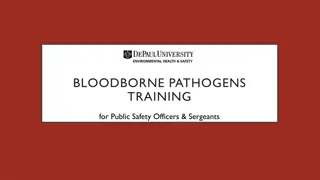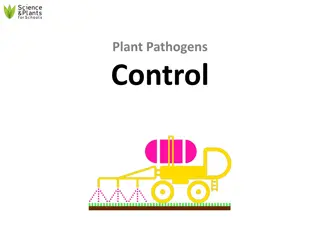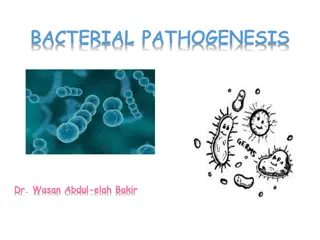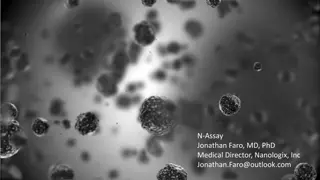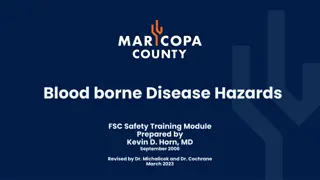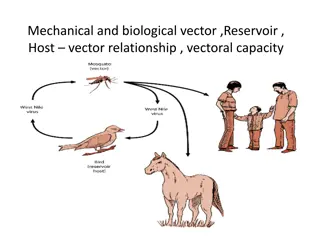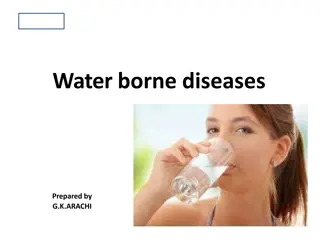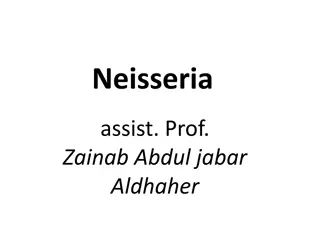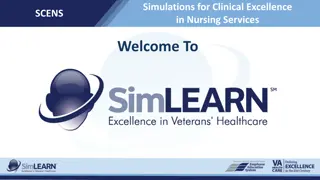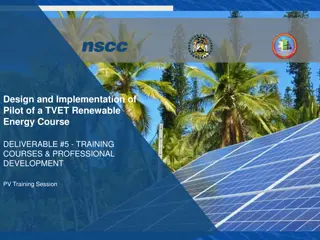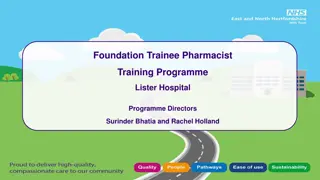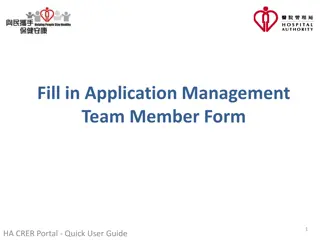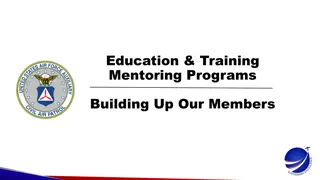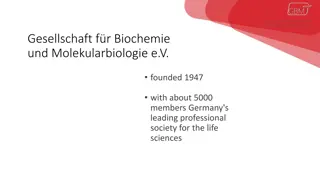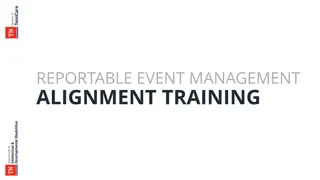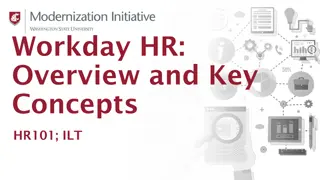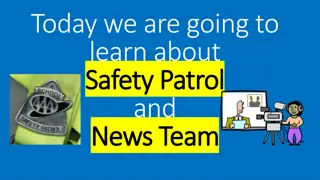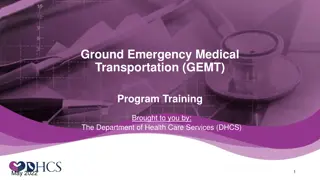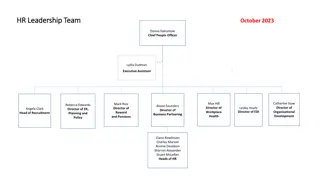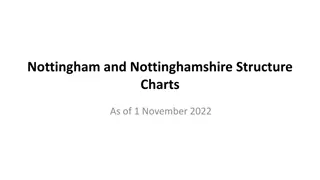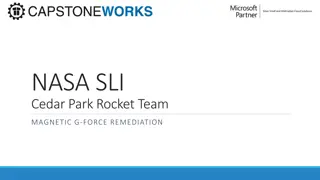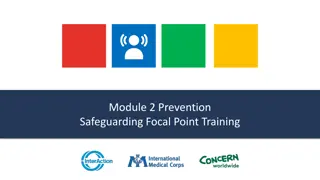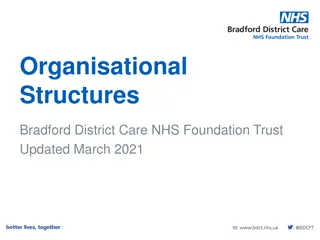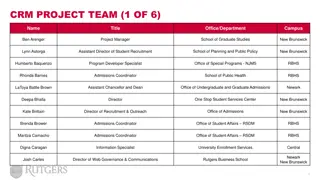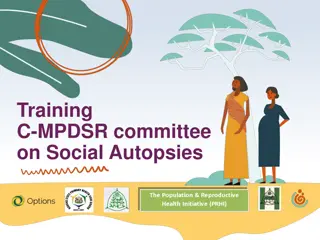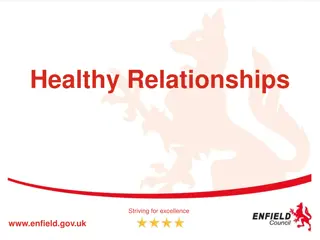Bloodborne Pathogens Training Overview for Ground Team Members
Understanding bloodborne pathogens is crucial for ground team members to protect themselves and others. This training covers what bloodborne pathogens are, focusing on Hepatitis B Virus (HBV) and Human Immunodeficiency Virus (HIV), their symptoms, transmission risks, and prevention methods. HBV facts highlight the infectious nature of the virus, while information on HIV explains its impact on the immune system. Recognizing symptoms and knowing how to prevent exposure are vital for emergency services personnel.
Download Presentation

Please find below an Image/Link to download the presentation.
The content on the website is provided AS IS for your information and personal use only. It may not be sold, licensed, or shared on other websites without obtaining consent from the author. Download presentation by click this link. If you encounter any issues during the download, it is possible that the publisher has removed the file from their server.
E N D
Presentation Transcript
Bloodborne Pathogens Training for Ground Team Members & Leaders Developed as part of the National Emergency Services Curriculum Project. Created 6/2003, Updated 3/2015
What are Bloodborne Pathogens? What are Bloodborne Pathogens? BBPs are disease causing micro-organisms that may be present in human blood. They may be transmitted with any exposure to blood or other potentially infectious material. Two pathogens (organisms) of significance are Hepatitis B Virus (HBV) and Human Immunodeficiency Virus (HIV) Both of these viruses can cause a life-threatening and/or life-long infection.
What is Hepatitis B? What is Hepatitis B? One of multiple viruses that cause illness directly affecting the liver A major cause of viral hepatitis which is preventable through immunization
Hepatitis B Symptoms Hepatitis B Symptoms Weakness, fatigue, anorexia (loss of appetite), nausea, abdominal pain, fever, headache, possible jaundice (a yellow discoloration of the skin). Blood will test positive for the HBV surface antigen within 2 to 6 weeks after symptoms develop. May show no symptoms and therefore not be recognized or diagnosed.
HBV Facts HBV Facts HBV is more infectious than HIV in that it is able to survive for at least a week in dried blood on environmental surfaces or contaminated instruments. Approximately 85% of patients recover in 6 8 weeks. 1 out of 20 people in the US have been infected with Hepatitis B. More than one million people are chronically infected. Up to 40,000 new people will become infected this year. Approximately 1 healthcare worker dies each day from Hepatitis B.
What is HIV? What is HIV? Human Immunodeficiency Virus is a virus that infects the T4 white blood cells in human immune systems and renders them less effective in preventing disease. It is the virus identified as being responsible for AIDS: Acquired Immunodeficiency Syndrome
HIV Symptoms HIV Symptoms Night sweats, weight loss, fever, fatigue, gland pain or swelling, muscle or joint pain. Individuals infected with HIV may feel fine and not be aware of the exposure/infection for as long as 8 10 years. Blood tests may not turn positive for as long as a year after exposure and therefore multiple tests may be required to determine if the person has been infected.
HIV Facts HIV Facts More than 1.2 million people in the US are living with HIV infection, and almost 1 in 7 are unaware of their infection. The estimated incidence of HIV has remained stable overall in recent years, at about 50,000 new HIV infections per year. An estimated 13,712 people with an AIDS diagnosis died in 2012, approximately 658,507 people in the US with AIDS have died overall.
Exposure Prevention for Bloodborne Pathogens Exposure Prevention for Bloodborne Pathogens Engineering Controls Work Practice Controls Personal Protective Equipment Universal Precautions
Engineering Controls Engineering Controls Structural or mechanical devices CAP provides for its ES personnel: Hand washing facilities Eye wash stations Sharps containers Biohazard labels
Work Practice Controls Work Practice Controls The behaviors necessary to use engineering controls effectively: Using sharps containers Using an eye wash station Washing your hands after removal of personal protective equipment
Work Practice Controls Work Practice Controls - - continued continued Hand washing is considered to be the most effective method of preventing transmission of BBPs. Alternatives such as alcohol based hand cleaners and towelettes are acceptable alternatives when ready access to wash facilities is not available. However, after contact with blood or other possible infectious material, the hands and any other contaminated body parts should still be washed with soap and water as soon as possible.
Work Practice Controls Work Practice Controls - - continued continued Procedures involving blood or other potentially infectious material will be performed in such a way as to minimize or eliminate splashing, spraying, splattering, and generation of airborne droplets of the substance. Eating, drinking, smoking, applying cosmetics or lip balm, and handling contact lenses is prohibited in work areas where exposure is possible.
Personal Protective Equipment Personal Protective Equipment Equipment provided by CAP at no cost to you, which it is to your advantage to use, and should be reported to supervisors when not in working order: Latex gloves Face masks Aprons, gowns, or Tyvek suits Face shields
Personal Protective Equipment Personal Protective Equipment - - continued continued Whenever you need to wear a face mask, you must also wear eye protection. When wearing personal glasses, you must use side shields and plan to decontaminate your glasses and side shields.
Personal Protective Equipment Personal Protective Equipment - - continued continued Personal protective equipment is acceptable if it prevents blood or other possible infectious material from contaminating work clothes, street clothes, undergarments, skin, eyes, mouth, or other mucous membranes.
What is wrong with the picture? What is wrong with the picture?
Use your Personal Protective Equipment Use your Personal Protective Equipment Answer: Rubber Gloves were not worn for the patient survey
Removing Gloves Removing Gloves Grasp the outer surface of one glove with the other gloved hand rubber to rubber and pull off the glove. Discard the glove into the designated receptacle. Removing the second glove. Note that the person touches only the inside surface of the glove with the bare hand.
Contaminated Clothing Contaminated Clothing Your clothing may be exposed to potentially infectious material and must be handled appropriately if that happens. Clearly label contaminated materials and put them into a separate leak-proof container to be sent disposed of according to OSHA standards. Don t handle contaminated clothing more than absolutely necessary.
Contaminated Clothing Removal Contaminated Clothing Removal Remove clothing in such a way as to avoid contact with the outer, contaminated surface: Use gloves when removing contaminated articles. Rolling the garment as it is pulled off will decrease the chance of contact with the contaminated area. After rolling up the contaminated area, carefully pull off the clothing to avoid contact. If it cannot be removed without contamination, it is recommended that the item be cut off.
Universal Precautions Universal Precautions The concept that all blood and certain body fluids are to be treated as if contaminated with HIV, HBV or other BBPs. An acceptable alternative is Body Substance Isolation: treating all fluids and substances as infectious. Personal protective equipment, such as gloves, mask and eye- shields, must be used whenever you might be exposed to blood or other potentially infectious materials.
Materials Requiring Universal Precautions Materials Requiring Universal Precautions Blood Cerebrospinal fluid Synovial (joint) fluid Pleural fluid Any body fluid with visible blood Any unidentifiable body fluid Saliva following dental procedures or injury
Materials NOT Requiring Universal Precautions Materials NOT Requiring Universal Precautions Feces Nasal secretions Sputum Sweat Tears Urine Vomit However, if blood is visible, treat the substance as contaminated.
Surface Decontamination Surface Decontamination Surfaces can be decontaminated with one of many commercial products. Check the product label directions for correct use. A bleach solution can be mixed using 1 part bleach to 10 parts water to disinfect areas. The solution should be made fresh before use
Biohazard Materials Biohazard Materials Biohazard symbol is used to identify biohazard materials. Protective gloves Protective face mask with eye shield
Biohazard Materials continued Biohazard Materials continued Sharps containers to hold contaminated needles, scalpels, or other sharp instruments. Tyvek protective suits for biohazard scenes such as accident sites. Biohazard kit for clean-up
Bloodborne Pathogen Tasks Bloodborne Pathogen Tasks General Emergency Services Personnel O-0901: Demonstrate knowledge of BBPs Ground Team Members O-0902: Exercise Universal Precautions Ground Team Leaders O-0903: Use a BBP Protective Suit Any products shown in these slides are for illustrative purposes only. Neither the Civil Air Patrol nor the US Air Force endorses, guarantees, or recommends any specific product, business, or services.
Questions? Think Safety



